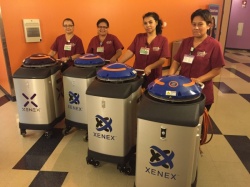Ultraviolet
The supergerm-zapping robot helpers
Half a million square feet. More than 350 beds. And tomorrow, they clean it all over again. Every day, Environmental Services (EVS) staff members work to disinfect every surface in Children’s Hospital Los Angeles, playing a crucial behind-the-scenes role in preventing infections and keeping patients safe. Now, on top of scrubbing, spraying, mopping and wiping, they can add another action – zapping.

“Cleaning is a fundamental function of any healthcare facility, and our housekeepers may go unnoticed because their work disinfecting the hospital often happens before patients even get to their rooms,” says Jill Hoffman, MD, a pediatric infectious disease specialist and medical director of infection prevention and control at Children’s Hospital Los Angeles. “We arm our doctors and nurses with high-tech tools and surgical robots, and now we are doing the same for those on the front line of our battle against infections.”
As hospitals across the country look for new, innovative ways to battle pathogens and multi-drug resistant organisms that put patients at risk, and as flu season draws closer, CHLA has introduced four new non-human team members that can annihilate potentially lethal germs and bacteria lurking in hard-to-reach places.
CHLA’s four new Xenex Germ-Zapping Robots – affectionately named Charlie, Ziggy, Phoenix and R2Clean2 – use pulsed xenon ultraviolet (UV-C) light, thousands of times more powerful than sunlight, to quickly destroy harmful bacteria, viruses, fungi and even bacterial spores. The portable disinfection system takes about 20 minutes per room – for a total of about an hour when combined with traditional cleaning techniques – and is effective against even the most dangerous pathogens, including Clostridium difficile (C-diff), norovirus, influenza and methicillin-resistant Staphylococcus aureus (MRSA).
Supplementing the work of more than 200 top-notch EVS/housekeeping staff, this new technology gives CHLA another tool to provide hospitalized infants, children and young adults the safest experience possible.
“Adding another layer of protection to our already robust infection prevention protocols allows us to be even more proactive in protecting our patients,” says Hoffman. “Children’s Hospital Los Angeles is nationally and internationally recognized for patient care, and even one hospital-acquired infection is one too many. These robots can help us advance towards our goal of zero infections.”
In fact, during a brief trial run with a Xenex robot earlier this year, CHLA was able to see a 10 percent reduction in infection rates in areas of the hospital tested. Other hospitals that have used the robots for longer periods have reported even more dramatic reductions – more than 50 percent in some cases – in C. diff and MRSA rates.
Source: Childrens Hospital Los Angeles
09.10.2015









